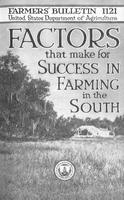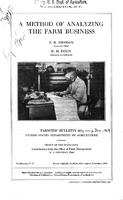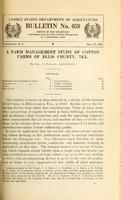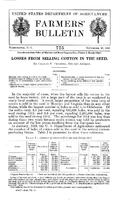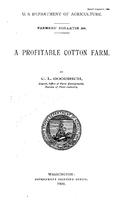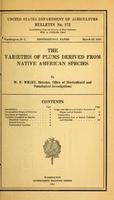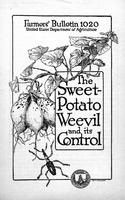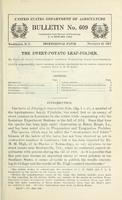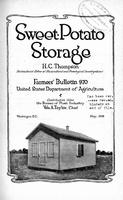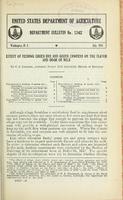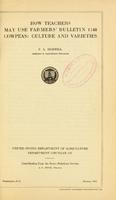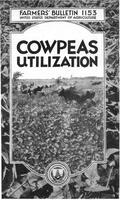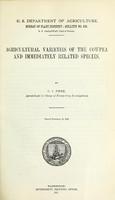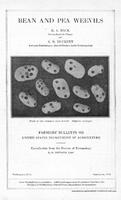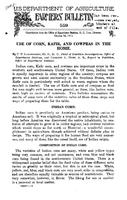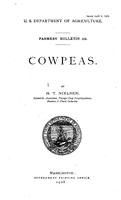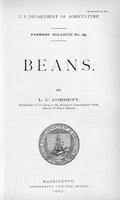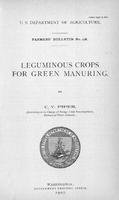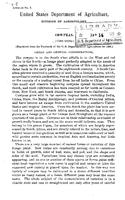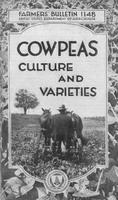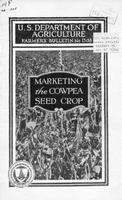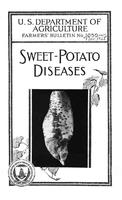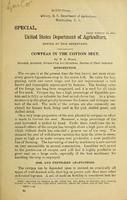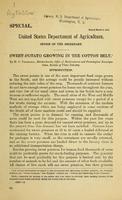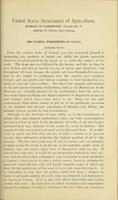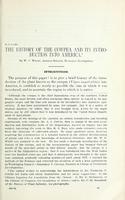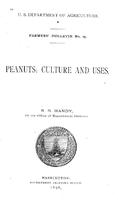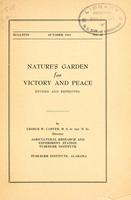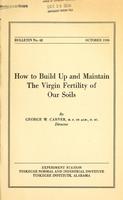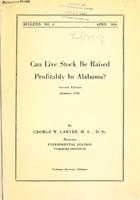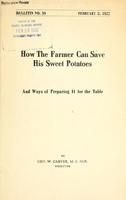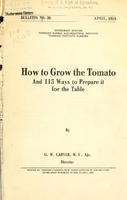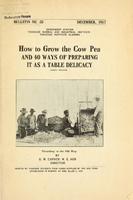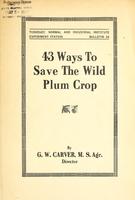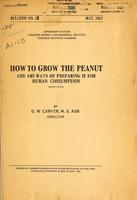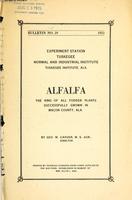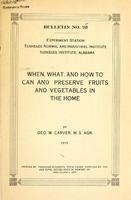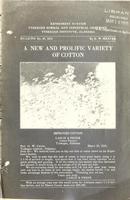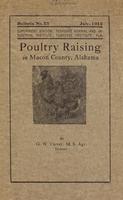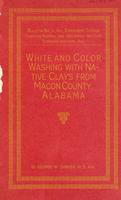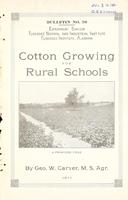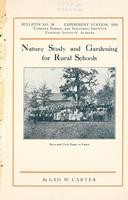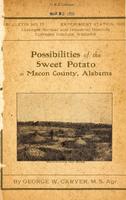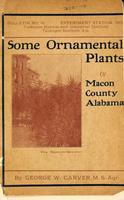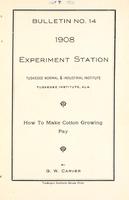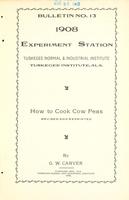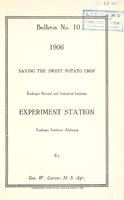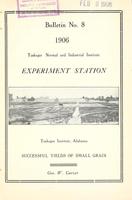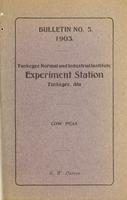Browse Items: 172
Factors That Make for Success in Farming in the South
THE FARMER invests capital in land, labor, and equipment for the production of crops, of live stock, and of animal products. It is self-evident that to reach the highest return for time and capital expended he must use his land and equipment, and expend his labor and supplies, with the greatest efficiency and economy possible under his particular…
A Method of Analyzing the Farm Business
FARMING is an art. It is also a science. But above and including both, farming is a business and the successful farmer is a business man. The basic qualities of a manufacturer, a financier, and a salesman combined in one man are essential to the efficient and successful management of a going farm enterprise.
Success on the farm primarily rests…
Success on the farm primarily rests…
A Method of Testing Farms in the South for Efficiency in Management
This circular is intended to present a method of testing farms for efficiency in management, with some general standards of efficiency, for the use of farm-management extension workers, county agents, farmers, and others, with special reference to agricultural conditions in the South. The method is by no means exhaustive in character, but it is…
A Farm Management Study of Cotton Farms of Ellis County, Tex.
This bulletin is based on data obtained in a survey of the business of 120 farms in Ellis County, Tex., in 1914. In this survey the following factors were taken into consideration: Value of farm property; proportion of capital invested in land, buildings, implements, and machinery; feed inventories and cash for operating expenses; labor…
Peanut Growing in the Cotton Belt
The value of the peanut, both as a money crop and for feeding on the farm, makes it especially desirable in the cropping system in some parts of the cotton belt. The commercial value of the crop increased from $7,270,515 in 1899 to $18,271,929 in 1909, and the increase since 1909 has been even greater than before that year. These figures do not…
Losses From Selling Cotton in the Seed
In the majority of cases, when the farmer sells his cotton in the seed he loses his money, yet a large part of the crop is so marketed in many local markets. A much larger proportion of the total crop of cotton is sold in the seed in Missouri and Virginia than in any other States, while the largest number of bales so sold is in Oklahoma. Of the…
A Profitable Cotton Farm
This bulletin is an account of the progressive and successful farm operations of a farmer of South Carolina who, by combining thorough tillage, crop rotation, barnyard manure, and a judicious use of commercial fertilizer, has changed a previously badly managed and run-down cotton farm into a very productive and profitable enterprise. The impulse…
The Varieties of Plums Derived From Native American Species
The development from the wild condition and the introduction into cultivation of the varieties of plums enumerated in the following pages have taken place within the last hundred years, much the larger proportion even within the past fifty years. For various reasons many of the varieties never attained more than a local reputation, while others did…
The Sweet-Potato Weevil and its Control
IMMENSE LOSSES of sweet potatoes in the Gulf States are being caused by the sweet-potato weevil. This foreign pest, introduced into the United States years ago, has become very destructive recently and now threatens to invade all States in which sweet potatoes are grown.
The slender, metallie-blue weevil, about a quarter of an inch long with…
The slender, metallie-blue weevil, about a quarter of an inch long with…
The Sweet-Potato Leaf Folder
The larva of Pilocrocis tripunctata Fab. (fig. 1 c, d), a member of the lepidopterous family Pyralidae, was noted first as an enemy of sweet potatoes in Louisiana by the writer while cooperating with the Louisiana Experiment Stations in the fall of 1914. Since that time the species has been kept under observation at Baton Rouge, La., and has been…
Sweet-Potato Storage
THE PROPER storage of sweet potatoes is one of the most important food conservation measures that can be put into effect in the Southern States. No perishable product produced in the South is of as great importance as the sweet potato, and none is so poorly handled.
This bulletin describes in considerable detail the types of storage houses that…
This bulletin describes in considerable detail the types of storage houses that…
Effect of Feeding Green Rye and Green Cowpeas on the Flavor and Odor of Milk
When dairy cows consumed 15 pounds of green rye one hour before milking only slight abnormal flavors and odors were produced in the milk.
Increasing the amount of green rye consumed one hour before milking from 15 to 30 pounds increased to a slight extent the abnormal flavors and odors in the milk. They were, however, only slight and would…
Increasing the amount of green rye consumed one hour before milking from 15 to 30 pounds increased to a slight extent the abnormal flavors and odors in the milk. They were, however, only slight and would…
How Teachers May Use Farmers' Bulletin 1148: Cowpeas: Culture and Varieties
THE TEACHING OF AGRICULTURE in any community should have a vital connection with the problems of the farms of that community. Pupils are interested in those things about which they have some knowledge. The type of agriculture practiced in the community can be used to the best advantage in teaching. Therefore the teacher should organize the…
Cowpeas: Utilization
THE COWPEA PLANT may be fed to live stock as pasturage, hay, or ensilage, and the seed may be used as human food. Cowpeas are not grown for seed more generally because of the uncertainty of the crop, the expense of harvesting, and the low yield commonly obtained. These factors have created a relatively high price for the seed.
In localities well…
In localities well…
Agricultural Varieties of the Cowpea and Immediately Related Species
The cowpea is now the most important legume grown in the cotton States. At the present time about 15 varieties of this crop are in common cultivation in these States. The varieties grown in a small way number perhaps twice as many more. Owing to the fact that the seed is still largely hand picked, the tendency is for whatever variety was first…
Beans, Peas, and Other Legumes as Food
The cowpea belongs to the bean family; but it is the "field pea" of the Southern States. There are several varieties—the "red" and "black" varieties, the round "lady" peas, the large "black-eye" and "purple-eye," and the variously mottled and speckled "whippoorwill" peas, besides many others. There are both trailing and bush varieties. The plant…
Bean and Pea Weevils
BEANS, PEAS, AND COWPEAS are often damaged seriously in storage and in the field by weevils. Velvet beans and soy beans are rarely infested in this country. Bean and pea weevils not only destroy much of the Nation's food in the form of leguminous crops hut are responsible for a curtailment in the acreage planted to these crops. They never attack…
Attractive Ways of Using Cowpeas
Since there is a large surplus of cowpeas just at this season we need to stress attractive ways of using them. They are a nourishing food and make good meat substitute dishes. The cowpeas for the loaf, croquettes and for salads are better if cooked in a fireless cooker from 4 to 5 hours.
Use of Corn, Kafir, and Cowpeas in the Home
The cowpea is a member of a large botanical family known as the Leguminosse, whose fruit or seeded pods are called legumes. It is said to be native to Africa and early in the eighteenth century was introduced into the United States by way of the West Indies. Gradually it spread northward and late in the century we have record of its cultivation as…
Cowpeas
A system of agriculture without the use of a leguminous crop tends to lessen the productivity of the soil and makes necessary large outlays for nitrogenous fertilizers. With a leguminous crop grown at frequent intervals, the productivity may be maintained or even increased. The cowpea (fig. 1) is at the present time, and probably will continue to…
Beans
The cowpea (Vigna sinensis), because of its bean-like seed and habit of growth, its great economic importance as a forage crop for the production of hay and silage, and its great value as a green manure, should be mentioned in connection with the other plants to which it is so closely related both botanically and economically.
Leguminous Crops for Green Manuring
The cowpea (fig. 5) is used more than any other crop as a soil renovator in the South. Its use is rapidly increasing, but is yet far from general. During the past few years the high price of the seed has tended to discourage more extensive growing. Recent progress in the harvesting of cowpea seed by machinery will doubtless materially reduce its…
Cowpeas
The chief functions of this crop, then, are to furnish large amounts of nitrogen abstracted from the air and fixed in the roots and stubble in a conveniently available form for the use of succeeding crops; second, to produce a large yield of vines and peas rich in digestible protein, which, either as hay or for soiling purposes, will take the place…
Cowpeas: (Vigna catjang)
The cowpea is to the South what alfalfa is to the West and red clover to the North — a forage plant perfectly adapted to the needs of the region where it grows. The cultivation of this crop in America dates back to the early part of the eighteenth century. A South Carolina planter received a quantity of seed from a foreign source, which, according…
Cowpeas: Culture and Varieties
THE COWPEA is the best known and most extensively grown leguminous crop in the Southern States. It is grown mainly for forage and to improve the soil, but the seeds are rather commonly used for human food.
The cowpea is of the greatest value in the cotton belt, although it can be grown profitably much farther north.
The cowpea will do best on…
The cowpea is of the greatest value in the cotton belt, although it can be grown profitably much farther north.
The cowpea will do best on…
Marketing the Cowpea Seed Crop
The annual farm value of cowpeas produced in the United States during recent years averages over $18,000,000. On most farms, however, the cowpea is grown largely as a catch crop, is considered of secondary importance as a money crop, and in many instances is handled in an unbusinesslike manner. This results not only in a direct monetary loss to the…
Sweet-Potato Diseases
DISEASES of sweet potatoes are divisible into two classes, (1) field troubles and (2) storage rots. Field troubles are divisible into root and stem diseases and leaf diseases.
Root and stem diseases include stem rot, black rot, foot rot, scurf, root rot, mottle necrosis, and soil rot; and leaf diseases include leaf blight, white rust, and leaf…
Root and stem diseases include stem rot, black rot, foot rot, scurf, root rot, mottle necrosis, and soil rot; and leaf diseases include leaf blight, white rust, and leaf…
Cowpeas in the Cotton Belt
The cowpea is at the present time the best known and most extensively grown leguminous crop in the cotton belt. Its value for hay, grazing, catch and cover crops, and for soil improvement is well known and thoroughly appreciated by farmers. The feeding value of the forage has long been recognized, and it is used for all kinds of live stock. Cowpea…
Sweet-Potato Growing in the Cotton Belt
The sweet potato is one of the most important food crops grown in the South, and the acreage could be greatly increased without reducing the unit value of the crop. Thousands of southern farmers do not have enough sweet potatoes for home use throughout the year, and very few of the small cities and towns in the South have a continuous or sufficient…
Sweet Potato Growing
A SUFFICIENT QUANTITY of sweet potatoes for home use can be grown under a wide range of conditions, but when the crop is to be produced commercially the soil, climate, and market should be carefully considered.
Sweet potatoes work in well with a rotation of farm or truck crops, and if improved methods of growing and storing the crop are employed…
Sweet potatoes work in well with a rotation of farm or truck crops, and if improved methods of growing and storing the crop are employed…
The Useful Properties of Clays
From the earliest dawn of history man has exercised himself in fashioning into products of beauty and utility the plastic materials which he found prepared for his hand on or under the surface of the earth. The stone age was followed by the bronze, and this in time by that of iron, and this in turn by the age of steam and electricity; but…
The History of the Cowpea and its Introduction Into America
The purpose of this paper is to give a brief history of the introduction of the plant known as the cowpea (Vigna unguiculata) into America, to establish as nearly as possible the time at which it was introduced, and to ascertain the region to which it is native.
Although the cowpea is the chief leguminous crop of the southern United States, the…
Although the cowpea is the chief leguminous crop of the southern United States, the…
Peanuts: Culture and Uses
The peanut (Arachis hypogwa), known also in different localities as the earthnut, groundnut, ground pea, goober, and pindar, is a trailing straggling annual, growing from 1 to 2 feet high, with thick, angular, pale-green, hairy stems, and spreading branches, and has the peculiar habit of maturing its fruit underground. (Strictly speaking it is not…
Building Up a Run-Down Cotton Plantation
This bulletin is an account of the progress made in three years in changing a run-down cotton plantation into a profitable stock and hay farm. The results obtained from the use of cowpeas and other leguminous crops in restoring the fertility of the land have exceeded the expectations of those in charge of the work. Not only have the crops yielded…
Nature's Garden for Victory and Peace
Since the article appeared in the Alabama Journal, Tuesday, February 10, 1942, by Mr. W. T, Maynor, captioned “Don’t Worry If War Causes Shortage of Green Vegetables, Weeds Are Good To Eat” the large number of letters that continue to come in asking for more information makes us feel that here is an opportunity to render a service much needed at…
How to Build Up and Maintain the Virgin Fertility of Our Soils
Origin of Scientific Agriculture
One is not only surprised but astonished to learn that less than a century and a half ago, agriculture was without a scientific working basis. Credit goes to the great German chemist, Justus von Liebig for starting this revolutionary movement. The following four laws which form the foundation of modern…
One is not only surprised but astonished to learn that less than a century and a half ago, agriculture was without a scientific working basis. Credit goes to the great German chemist, Justus von Liebig for starting this revolutionary movement. The following four laws which form the foundation of modern…
Can Live Stock Be Raised Profitably in Alabama?
I am confident that no other time has been more favorable than the present for every farmer in Alabama to think seriously and constructively along this line, asking himself the following questions. (I feel equally sure that with the facts before him he will have little or no trouble in deciding what course to take.)
QUESTIONS AND ANSWERS
No.…
QUESTIONS AND ANSWERS
No.…
The Raising of Hogs: One of the Best Ways to Fill the Empty Dinner Pail
With sugar cured hams selling for 26 cents per pound, bacon sliced selling for 36 cents per pound, lard selling for 19 cents per pound, and unsmoked white meat selling for 23 cents per pound, it does not require the wisdom of a philosopher to see that the bulk mass of dinner pails must remain only partially filled or entirely empty in so far as the…
How to Make and Save Money on the Farm
Foreword
Bulletin No. 39 from the Alabama Experiment Station located at Tuskegee Institute under the direction of Dr. George W. Carver, is being issued at a very opportune time. The problem of farm management is becoming more and more serious every year. It is not that there is any falling off in production; in fact there has been a great…
Bulletin No. 39 from the Alabama Experiment Station located at Tuskegee Institute under the direction of Dr. George W. Carver, is being issued at a very opportune time. The problem of farm management is becoming more and more serious every year. It is not that there is any falling off in production; in fact there has been a great…
How the Farmer Can Save His Sweet Potatoes and Ways of Preparing It for the Table
There are but few if any of our staple farm crops, receiving more attention than the sweet potato, and indeed rightfully so. The splendid service it rendered during the great World War in the saving of wheat flour, will not soon be forgotten. The 99 different and attractive products (to date) made from it, are sufficient to convince the most…
How to Make Sweet Potato Flour, Starch, Sugar, Bread and Mock Cocoanut
SWEET POTATO FLOUR
There are several grades of this product and quite as many ways to manufacture them. Each one of these flours or meals (as most millers insist upon calling them) has a particular character of its own and is therefore adapted to certain uses the other products are not.
These Sweet Potato flours are generally speaking of…
There are several grades of this product and quite as many ways to manufacture them. Each one of these flours or meals (as most millers insist upon calling them) has a particular character of its own and is therefore adapted to certain uses the other products are not.
These Sweet Potato flours are generally speaking of…
How to Grow the Tomato and 115 Ways to Prepare it for the Table
But few people realize what an important vegetable the tomato is. While it is true that chemical analysis does not place it very high in the nutritive scale, if viewed from this angle alone its real value will be greatly underestimated.
For the reasons which follow, every normal person should make the tomato a very prominent part of the weekly…
For the reasons which follow, every normal person should make the tomato a very prominent part of the weekly…
How to Grow the Cow Pea and 40 Ways of Preparing It as a Table Delicacy
Among the many rich blessings especially given to the South, there are but few, if any, that stand out more prominently than the cow pea, for the following reasons:
1. It is a legume (pod-bearing plant), and brings fertility to the soil. In this it has but few equals, and still fewer superiors.
2. As a food for man and beast the peas are…
1. It is a legume (pod-bearing plant), and brings fertility to the soil. In this it has but few equals, and still fewer superiors.
2. As a food for man and beast the peas are…
43 Ways to Save the Wild Plum Crop
Nature endows or blesses each State or section with an indigenous flora and fauna best suited to that particular soil and climatic conditions.
Applying the above to Alabama, Macon and adjoining counties have been unusually blessed in the quantity, variety and quality of its wild plums. They vary in size from a half to one inch in diameter, and…
Applying the above to Alabama, Macon and adjoining counties have been unusually blessed in the quantity, variety and quality of its wild plums. They vary in size from a half to one inch in diameter, and…
Twelve Ways to Meet the New Economic Conditions Here in the South
It needs but little or no discussion to convince us that we are on the beginning of the most perplexing, most interesting, and the most important period of our lives.
We are confronted with new economic conditions; the problems of last year are not the problems of this year; yea, the problems of yesterday are greatly overshadowed by the problems…
We are confronted with new economic conditions; the problems of last year are not the problems of this year; yea, the problems of yesterday are greatly overshadowed by the problems…
Three Delicous [sic] Meals Every Day for the Farmer
As we learn more about ourselves and the relation of food to our well being, we cannot but agree with those who have made it a study that ‘the prosperity of the nation depends upon the health and morals of its citizens, and the health and morals of a people depend mainly upon the food they eat, and the homes in which they live.’
As a rule, we…
As a rule, we…
How to Grow the Peanut: And 105 Ways of Preparing It for Human Consumption
Of all the money crops grown by Macon County farmers, perhaps there are none more promising than the peanut in its several varieties and their almost limitless possibilities.
Of the many good things in their favor, the following stand out as most prominent:
1. Like all other members of the pod-bearing family, they enrich the soil.
2. They…
Of the many good things in their favor, the following stand out as most prominent:
1. Like all other members of the pod-bearing family, they enrich the soil.
2. They…
Alfalfa: The King of All Fodder Plants, Successfully Grown in Macon County, Ala.
For many years we have been testing in one way or another almost every variety of legume that seemed in the least promising, with the view to finding one or more that would succeed in this section and give us a permanent pasture without having to prepare and re-seed the ground each year.
Alfalfa has really gone beyond the high standard set by…
Alfalfa has really gone beyond the high standard set by…
When, What, and How to Can and Preserve Fruits and Vegetables in the Home
There is without doubt no activity connected with the farm or garden of greater importance than the canning and preserving of fruits and vegetables. The following are some of the strongest arguments in its favor:
1. It is the easiest, cheapest, quickest, and best method yet devised by which we can have plenty of good, wholesome fruits and…
1. It is the easiest, cheapest, quickest, and best method yet devised by which we can have plenty of good, wholesome fruits and…
A New and Prolific Variety of Cotton
Sixteen years ago the Experiment Station undertook the production of a type of cotton that would possess the following characteristics:
1. A longer and finer staple.
2. A more prolific variety.
3. A disease resistant variety.
4. A cotton that produces well on light, sandy soils.
5. An early maturing variety that would escape…
1. A longer and finer staple.
2. A more prolific variety.
3. A disease resistant variety.
4. A cotton that produces well on light, sandy soils.
5. An early maturing variety that would escape…
Study of the Soils of Macon County, Alabama, and Their Adaptability to Certain Crops
LOCATION AND BOUNDARIES
Macon County, “the garden-spot of Alabama,” lies near the eastern boundary of the State, about 135 miles north of the Florida-Alabama line. It has an area of 621 square miles, embodying 397,440 acres. It is 34 miles in extent from east to west, and 24 3/4 miles from north to south. The northern and western boundary lines…
Macon County, “the garden-spot of Alabama,” lies near the eastern boundary of the State, about 135 miles north of the Florida-Alabama line. It has an area of 621 square miles, embodying 397,440 acres. It is 34 miles in extent from east to west, and 24 3/4 miles from north to south. The northern and western boundary lines…
Pickling and Curing of Meat in Hot Weather
Many and varied are the methods of curing and otherwise preserving meat in the fall and winter months when the weather is cold enough to insure success.
All the methods examined were successful and some of superior merit, but the notion of killing and preserving meat in hot weather had scarcely been given a thought; “impossible” seemed to have…
All the methods examined were successful and some of superior merit, but the notion of killing and preserving meat in hot weather had scarcely been given a thought; “impossible” seemed to have…
Poultry Raising in Macon County, Alabama
Of all the get-rich-quick schemes there is probably none more productive of delusion than that of poultry raising on paper. And yet, with the proper facilities and applied intelligence, possibly more handsome returns can be had from poultry than any other industry in proportion to the amount of capital invested and the readiness with which results…
White and Color Washing with Native Clays from Macon County, Alabama
Of the many attractive features of our beautiful county, I think there is possibly none that elicit such universal admiration and praise as the vast deposits of multi-colored clays, ranging from snow-white, through many gradations, to the richest Sienna and Indian reds on the one hand, and from the deepest yellow ochre to the palest cream tintings…
Cotton Growing for Rural Schools
There is doubtless no plant more interesting to the casual observer, or more useful economically and more wonderful to the searcher for truth than the cotton plant. It forms the principal products of eight great states of this Union. It also has an ancient history. It is said to have been grown and manufactured into clothing over 2,500 years ago.…
Some Possibilities of the Cow Pea in Macon County, Alabama
The cow pea is rightfully looked upon by many as the poor man’s bank or mortgage-lifter. I think I am safe in the assertion that there is no crop grown in the South which possesses so many good qualities and is so easily grown as the cow pea.
It is a matter of much regret that every colored farmer in Macon County does not plant at least three…
It is a matter of much regret that every colored farmer in Macon County does not plant at least three…
Nature Study and Gardening for Rural Schools
Since the publication of Teachers’ Leaflet No. 2, Nature Study and Children’s Gardens, the work has not only grown in a satisfactory manner, but has advanced far beyond the most sanguine hopes of its promoters — indeed the 1,500 copies of this leaflet which was published in 1904 have been exhausted without satisfying the increasing demand.
The…
The…
Possibilities of the Sweet Potato in Macon County, Alabama
If there is one crop more than another, that Macon County can produce year by year and with almost unerring certainty, it is the sweet potato crop.
Now what is true of Macon County is true of the adjoining counties, and is more or less true of the entire South.
HISTORY
It is said that the early navigators of the sixteenth century…
Now what is true of Macon County is true of the adjoining counties, and is more or less true of the entire South.
HISTORY
It is said that the early navigators of the sixteenth century…
Some Ornamental Plants of Macon County, Alabama
There is probably no section of our country that furnishes more really beautiful and useful ornamental plants than this section of Alabama; indeed the landscape gardener and florist, alike can find flowers of rare beauty and fragrance, foliage unsurpassed in richness, and fruits, berries and other forms of seed capsules possessing a richness of…
Increasing the Yield of Corn
When we consider that Alabama alone cultivated, in 1907, 2,961,000 acres in corn with an average of only 15 1-2 bushels to the acre, it at once becomes apparent that something must be done to bring up this unfortunately low yield per acre. It is further accentuated from the fact that within the last ten years the average has never been higher than…
How to Make Cotton Growing Pay
Two years of cotton experimentation have come and gone since the issue of Bulletin 7 of this station, on Cotton Growing on Sandy Upland Soils; in that bulletin we took the position that every acre in Alabama capable of growing cotton , could and should be made to produce a bale of cotton to the acre.
The bulletin further shows that the above…
The bulletin further shows that the above…
How to Cook Cow Peas
Since the publication of this bulletin the applications for it have steadily increased until the output of 1,500 has been exhausted and the demand unsupplied; and with this apology it was thought wise to republish it.
The popularity of the cow pea is increasing from every point of view from year to year. Someone has wisely said that as a crop,…
The popularity of the cow pea is increasing from every point of view from year to year. Someone has wisely said that as a crop,…
Saving the Wild Plum Crop
Nature endows or blesses each state or section with an indigenous flora and fauna best suited to that particular soil and climatic conditions.
Applying the above to Alabama, Macon and adjoining counties have been unusually blessed in the quantity, variety and quality of its wild plums.
They vary in size from a half to one inch in diameter, and…
Applying the above to Alabama, Macon and adjoining counties have been unusually blessed in the quantity, variety and quality of its wild plums.
They vary in size from a half to one inch in diameter, and…
Saving the Sweet Potato Crop
Of the many vexing problems with which the Southern farmer must deal, there are probably none more troublesome than the saving of his sweet potato crop.
Some years, all methods, from the simplest to the most complex, seem to succeed. Probably the very next year just the reverse is true, and all spoil, leaving in many instances hardly enough for…
Some years, all methods, from the simplest to the most complex, seem to succeed. Probably the very next year just the reverse is true, and all spoil, leaving in many instances hardly enough for…
Successful Yields of Small Grain
This bulletin, also, is a continuation of 6 and 7 and endeavors to thwart the very prevalent idea that small grain cannot be profitably raised in this section.
THE CAUSE
It is just as applicable to apply the cause and effect rule to every operation of the farm as to the various branches of mathematics, there being no cause without an effect…
THE CAUSE
It is just as applicable to apply the cause and effect rule to every operation of the farm as to the various branches of mathematics, there being no cause without an effect…
Cotton Growing on Sandy Upland Soils
This bulletin, in some degree is a continuation of No.6, on Soil Building, and emphasizes rather emphatically the possibilities of such soils in the production of cotton.
We have maintained that every acre of land in Alabama capable of being grown in cotton, could and should be made to produce at least one bale to the acre. The experiment…
We have maintained that every acre of land in Alabama capable of being grown in cotton, could and should be made to produce at least one bale to the acre. The experiment…
How to Build Up Worn Out Soils
The subject of soil improvement through natural agencies has been one of much concern to both ancient and modern agriculturists.
The ancient Egyptian knew that if he let his land lie idle, (rested) as he termed it, he was able to produce a much better crop, and that crop would be in quantity and quality, all other things being equal,…
The ancient Egyptian knew that if he let his land lie idle, (rested) as he termed it, he was able to produce a much better crop, and that crop would be in quantity and quality, all other things being equal,…
Cow Peas
Every year the demand for an increased quantity and better quality of nutritious forage for animals, and a wider range of food stuffs for man has suggested a basis for some very careful and interesting study. Experiment Stations, as well as individuals, have devoted much time and means to this line of investigation. Plants of many different genera,…
Some Cercosporae of Macon County, Alabama
The wide distribution and the economic importance of the Cercospora in this county has prompted the writing of this paper. This list by no means represents all of the species of this county, as no special effort has been made to collect Cercospora only. These collections were made while passing to and from other duties. With few exceptions, the…
Fertilizer Experiments on Cotton
The cotton fertilizer experiments made in 1898 are a continuation of a series of fertilizer soil tests commenced in 1897. The soil of the experimental field, a part of the station farm, is a light and sandy upland, with yellow clay subsoil.
The soil selected is excellently adapted for experimental purposes, having formed part of an old field…
The soil selected is excellently adapted for experimental purposes, having formed part of an old field…
Experiments With Sweet Potatoes
In summing up and drawing conclusions from this experiment, I think it quite safe to conclude that, with the proper management, 500 bushels of sweet potatoes can be produced on one acre of our ordinary potato soils ; since 266 bushels were produced under the following trying conditions:
First — Abnormally poor soil, physically, mechanically and…
First — Abnormally poor soil, physically, mechanically and…
Feeding Acorns
In this beautiful Southland of ours, with so many natural resources, and the repeated failures of the North, East and West to supply the ever-increasing demand for pork, dairy products, etc., has led us to turn much of our attention in this direction.
The great quantity of acorns produced in our oak forests, which have been hitherto practically…
The great quantity of acorns produced in our oak forests, which have been hitherto practically…
 An official website of the United States government.
An official website of the United States government.


